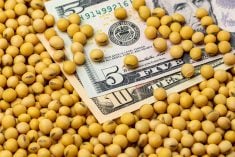Western Canadian feeder cattle prices were generally steady with week-ago levels, with auction barns experiencing lower volumes. The cow-calf producer has hopes of higher prices later in summer, and with plentiful forage supplies and favourable pasture conditions, there is little incentive to move cattle to auction.
Backgrounding operators have also finished liquidating fall-placed calves, resulting in lighter receipts for heavier replacements. Feedlot operators sold fed cattle in Alberta at $123.50 last week, resulting in the third week of positive closeouts, but this has done little to spur on demand. Weaker fed values in the U.S. southern Plains and softer wholesale values have finishing operators in Feedlot Alley of Alberta on the defensive.
Read Also

U.S. grains: Soy futures post biggest monthly gain in nearly five years on China trade optimism
U.S. soybean futures climbed to a 15-month high and posted their biggest monthly gain in nearly five years on Friday following a rally fueled by the prospect of revived exports to China.
Small groups of feeder cattle were noted this week, resulting in an ill-defined market and sharp discounts on any deficient quality. A mixed group of Angus-based, medium-frame, fairly green steers, weighing just over 500 pounds, sold for $163 per hundredweight (cwt) north of Calgary. In central Alberta, Charolais-cross steers weighing 725 lbs. sold for $144/cwt; mixed steers averaging 850 lbs. sold for $144/cwt at the same sale. Stronger buying interest was noted on replacement heifers and cow-calf pairs.
Crop reports are favourable in Western Canada and across the U.S. Midwest, which has finishing feedlot operators factoring in lower cost-per-pound gains, longer-term. However, there is still a fair amount of time before the crop is in the bin, so this optimistic thinking may be a bit premature. New-crop barley prices are a sharp discount to nearby values; farmers are not selling the upcoming crop at the lower prices at this time. In the short term, feeder cattle prices will likely remain flat, because the fed market feels heavy at the current levels and feedgrain prices will stay firm until harvest.
U.S. weekly beef production was higher than last year for the week ending June 8, which will continue to weigh on wholesale beef prices. U.S. marketing weights are increasing and feedlots are not current with production. There is a very strong seasonal trend for the fed market to soften through June. These factors will also temper any strength in the feeder complex.












